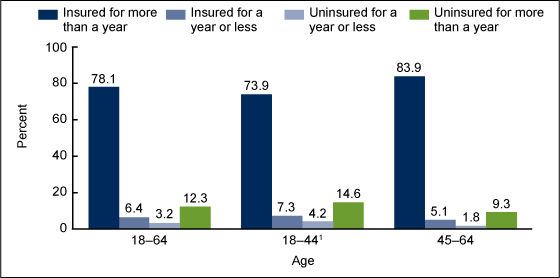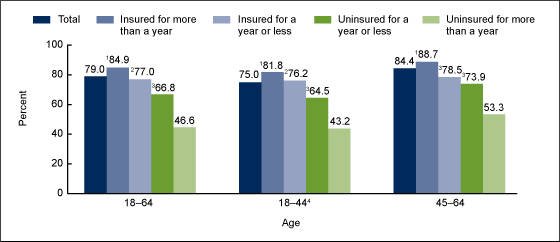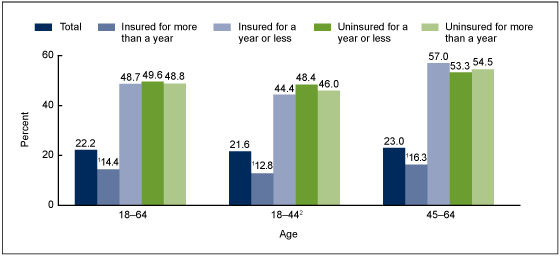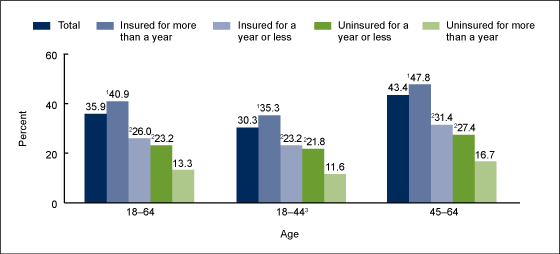Health Insurance Continuity and Health Care Access and Utilization, 2014
On This Page
- Key findings
- About 8 out of 10 adults aged 18–64 had health insurance coverage for more than a year.
- Adults with health insurance coverage for more than a year were more likely to have a usual place for medical care than those with any period of noncoverage.
- Adults insured for more than a year were more likely to have visited a doctor or other health care professional during the past year than those with any period of noncoverage.
- Adults with any period without health insurance in the past year were more likely to have had an unmet medical need due to cost than those with coverage for more than a year.
- Adults with health insurance coverage for more than a year were more likely to have been vaccinated to protect against the flu than those with any period of noncoverage.
- Summary
- Definitions
- Data source and methods
- About the authors
- References
- Suggested citation
NCHS Data Brief No. 249, May 2016
PDF Version (325 KB)
Maria A. Villarroel, Ph.D. and Robin A. Cohen, Ph.D.
Key findings
Data from the National Health Interview Survey
- During 2014, 78.1% of adults aged 18–64 were insured at the time of interview and had been insured for more than a year.
- About 6.4% of adults were insured at the time of interview but had a period of no insurance in the past year.
- About 12.3% of adults were uninsured at the time of interview and had been uninsured for more than a year, and 3.2% were uninsured at the time of interview but had a period of insurance coverage in the past year.
- Those insured at the time of interview and insured for more than a year were more likely than those with any period of no insurance to have a usual place of care, visited a health care provider, received a flu vaccine, and were less likely to have had an unmet medical need due to cost.
Between 2013 and 2014, almost 8 million adults aged 18–64 gained health care coverage, although 44 million adults were uninsured for at least part of the past year in 2014 (1). Having health insurance may facilitate the use of health services (2). Some studies of young adults who gained dependent coverage as a result of the Affordable Care Act found increases in having a primary care doctor and decreases in forgone care (3,4). However, other studies found no impact on visits to outpatient care facilities, primary care physicians, or emergency departments (5). This report explores access to and utilization of care among adults aged 18–64 according to health insurance status at the time of interview and during the preceding year.
Keywords: medical care, unmet medical needs, health care coverage, National Health Interview Survey
About 8 out of 10 adults aged 18–64 had health insurance coverage for more than a year.
- During 2014, 78.1% of adults aged 18–64 were insured at the time of interview and had been insured for more than a year, while 6.4% were insured at the time of interview but had a period of no insurance in the past year, 3.2% were uninsured at the time of interview but had a period of insurance coverage in the past year, and 12.3% were uninsured at the time of interview and had been uninsured for more than a year (Figure 1).
- Adults aged 18–44 were more likely than those aged 45–64 to be insured at the time of interview but to have had a period of no insurance in the past year (7.3% compared with 5.1%), to be uninsured at the time of interview but to have had a period of insurance in the past year (4.2% compared with 1.8%), and to have been uninsured for more than a year (14.6% compared with 9.3%).
Figure 1. Percent distribution of adults aged 18–64 according to health insurance coverage status at the time of interview and during the preceding year, by age group: United States, 2014
1Significantly different from those aged 45–64 for all coverage statuses (p < 0.05).
NOTES: “Insured for more than a year” includes adults who were insured at the time of interview and had been insured for more than a year. “Insured for a year or less” includes adults who were insured at the time of interview but had a period of no insurance in the past year. “Uninsured for a year or less” includes adults who were uninsured at the time of interview but had a period of insurance in the past year. “Uninsured for more than a year” includes adults who were uninsured at the time of interview and had been uninsured for more than a year. Access data table for Figure 1.
SOURCE: NCHS, National Health Interview Survey, 2014, Family Core component.
Adults with health insurance coverage for more than a year were more likely to have a usual place for medical care than those with any period of noncoverage.
- More than 8 in 10 adults aged 18–64 (82.8%) had a usual place for medical care (Figure 2).
- The percentage of adults aged 18–64 who had a usual place for medical care was higher among those insured for more than a year (90.8%) compared with those insured at the time of interview but had a period of no insurance in the past year (73.6%), those uninsured at the time of interview but had a period of insurance in the past year (57.8%), and those uninsured for more than a year (44.3%).
- Adults who were insured at the time of interview but had a period of no insurance in the past year were more likely to have a usual place for medical care than those uninsured at the time of interview but had a period of insurance in the past year or those uninsured for more than a year.
- Adults who were uninsured at the time of interview but had a period of insurance in the past year were more likely to have a usual place for medical care than those who were uninsured for more than a year.
- Among adults with the same health insurance coverage status, those aged 45–64 were more likely than those aged 18–44 to have a usual place for medical care.
Figure 2. Percentage of adults aged 18–64 with a usual place for medical care according to health insurance coverage status at the time of interview and during the preceding year, by age group: United States, 2014
1Significantly different from those who were insured for a year or less, uninsured for a year or less, or uninsured for more than a year (p < 0.05).
2Significantly different from those who were uninsured for a year or less or uninsured for more than a year (p < 0.05).
3Significantly different from those who were uninsured for more than a year (p < 0.05).
4Significantly different from those aged 45–64 for total and within each coverage status (p < 0.05).
NOTE: Access data table for Figure 2.
SOURCE: NCHS, National Health Interview Survey, 2014, Family Core and Sample Adult components.
Adults insured for more than a year were more likely to have visited a doctor or other health care professional during the past year than those with any period of noncoverage.
- Nearly 8 in 10 adults (79.0%) visited a doctor or other health care professional about their health at least once in the past year (Figure 3).
- The percentage who visited a doctor or health care provider during the past year was higher among those insured for more than a year (84.9%) compared with those insured at the time of interview but had a period of no insurance in the past year (77.0%), those uninsured at the time of interview but had a period of insurance coverage in the past year (66.8%), and those uninsured for more than a year (46.6%).
- Among adults aged 18–44, the percentage who visited a doctor or health care provider during the past year differed by duration of health insurance status. Among adults aged 45–64, those who were insured for more than a year (88.7%) were more likely to have visited a doctor or health care professional in the past year than those with any period of noncoverage in the past year. Those insured for a year or less (78.5%) and those uninsured for a year or less (73.9%) were more likely to have visited a doctor or health care professional than those uninsured for more than a year (53.3%).
- Except for those insured at the time of interview but had a period of no insurance in the past year, those aged 45–64 were more likely than those aged 18–44 of the same insurance status to have visited a doctor or health care provider in the past year.
Figure 3. Percentage of adults aged 18–64 who visited a doctor or other health care professional about their own health at least once in the past year according to health insurance coverage status at the time of interview and during the preceding year, by age group: United States, 2014
1Significantly different from those who were insured for a year or less, uninsured for a year or less, or uninsured for more than a year (p < 0.05).
2Significantly different from those who were uninsured for a year or less or uninsured for more than a year (p < 0.05).
3Significantly different from those who were uninsured for more than a year (p < 0.05).
4Significantly different from those aged 45–64 for total, insured for more than a year, uninsured for a year or less, and uninsured for more than a year (p < 0.05).
NOTE: Access data table for Figure 3.
SOURCE: NCHS, National Health Interview Survey, 2014, Family Core and Sample Adult components.
Adults with any period without health insurance in the past year were more likely to have had an unmet medical need due to cost than those with coverage for more than a year.
- One in five adults aged 18–64 (22.2%) had an unmet medical need due to cost in the past year (Figure 4).
- About 14% of adults aged 18–64 who were insured for more than a year had an unmet medical need due to cost in the past year, while three times as many of those with any duration of noncoverage in the past year had an unmet need: 48.7% of those insured at the time of interview but had a period of no insurance in the past year, 49.6% of those uninsured at the time of interview but had a period of insurance in the past year, and 48.8% of those uninsured for more than a year.
- Among adults of the same insurance status, those aged 45–64 were more likely than those aged 18–44 to have an unmet medical need due to cost in the past year: 16.3% compared with 12.8% among those who were insured for more than a year, 57.0% compared with 44.4% among those who were insured at the time of the interview but had a period of no insurance in the past year, and 54.5% compared with 46.0% among those who were uninsured for more than a year.
Figure 4. Percentage of adults aged 18–64 who had an unmet medical need due to cost in the past year according to health insurance coverage status at the time of interview and during the preceding year, by age group: United States, 2014
1Significantly different from those who were insured for a year or less, uninsured for a year or less, or uninsured for more than a year (p < 0.05).
2Significantly different from those aged 45–64 for total, insured for more than a year, insured for a year or less, and uninsured for more than a year (p < 0.05).
NOTES: Unmet medical need is a composite measure that includes prescription medicines, mental health care or counseling, dental care, eyeglasses, or needed medical care that the respondent did not get or delayed because of cost. Access data table for Figure 4.
SOURCE: NCHS, National Health Interview Survey, 2014, Family Core and Sample Adult components.
Adults with health insurance coverage for more than a year were more likely to have been vaccinated to protect against the flu than those with any period of noncoverage.
- About 36% of adults aged 18–64 received a flu vaccine in the past year (Figure 5).
- Among adults aged 18–64, those who were insured for more than a year (40.9%) were more likely to be vaccinated for the flu compared with those insured at the time of interview but had a period of no insurance in the past year (26.0%), those uninsured at the time of interview but had a period of insurance in the past year (23.3%), and those uninsured for more than a year (13.3%).
- Among both adults aged 18–44 and 45–64, those who were uninsured for more than a year were less likely to be vaccinated for the flu compared with those of the same age group who were either insured at the time of interview but had a period of no insurance in the past year or those who were uninsured at the time of interview but had a period of insurance in the past year.
- Adults aged 45–64 were more likely to have been vaccinated for the flu than those aged 18–44 with the same insurance coverage status, for those insured for more than a year, those insured at the time of interview but had a period of no insurance in the past year, and those uninsured for more than a year.
Figure 5. Percentage of adults aged 18–64 who had a flu vaccine during the past year according to health insurance coverage status at the time of interview and during the preceding year, by age group: United States, 2014
1Significantly different from those who were insured for a year or less, uninsured for a year or less, or uninsured for more than a year (p < 0.05).
2Significantly different from those uninsured for more than a year (p < 0.05).
3Significantly different from those aged 45–64 for total, insured for more than a year, insured for a year or less, and uninsured for more than a year (p < 0.05).
NOTE: Access data table for Figure 5.
SOURCE: NCHS, National Health Interview Survey, 2014, Family Core and Sample Adult components.
Summary
Persons currently with health insurance coverage either had continuous coverage for a period of time or had experienced a period of noncoverage. Likewise, those who are currently uninsured either have been continuously uninsured or have experienced a period of coverage in the recent past. The National Health Interview Survey (NHIS) permits the examination of continuity of health insurance in the past year. This report examined the association of health insurance continuity in the past year with health care access and utilization of health services.
Having insurance coverage at any given time in the past year increased the likelihood that adults had a usual place for medical care, visited a doctor or health care professional about their health, and received a flu vaccine. However, those with continuous health insurance coverage at the time of interview for more than a year were the most likely to have a usual place for medical care and to have used health services during this period, relative to those without continuous health insurance coverage.
Persons who have experienced a period of noncoverage may experience barriers to accessing and using health services. NHIS did not collect information on when the period of coverage and noncoverage began within the past year for those who were not continuously insured or uninsured. Despite this limitation, the findings show that any period without health insurance coverage in the past year, even if there was a change to gaining health insurance coverage, increased the likelihood of having had an unmet medical need in the past year, relative to those continuously insured.
Persistent lack of coverage, as reflected in those who have been uninsured for more than a year, was associated with the least use of health services and access to care, hindering opportunities for preventive medical care in this segment of the population.
Definitions
Health insurance coverage: Based on survey questions that help determine health insurance coverage at the time of interview. Insurance coverage includes private health insurance, Medicare, Medicaid, State Children’s Health Insurance Program (CHIP), a state-sponsored health plan, other government programs, or military health plans.
Duration of health insurance coverage: Persons who were insured at the time of interview were asked whether there was any time that they did not have health insurance in the past 12 months and, if so, how many months they were without insurance. Persons without insurance at the time of interview were asked about the last time they had insurance. Adults were classified as follows: insured at the time of interview and had been insured for more than a year, insured at the time of interview but had a period of no insurance in the past year, uninsured at the time of interview but had a period of insurance in the past year, and uninsured at the time of interview and had been uninsured for more than a year.
Usual place of care: Based on a positive response to the survey question: “Is there a place that you usually go to when you are sick or need advice about your health?” Adults whose usual place of care was the hospital emergency room were considered not to have a usual place of care.
Visit to a doctor or health care provider: Based on a response of one or more visits to the survey question: “During the past 12 months, how many times have you seen a doctor or other health care professional about your own health at a doctor’s office, a clinic, or some other place? Do not include times you were hospitalized overnight, visits to hospital emergency rooms, home visits, dental visits, or telephone calls.”
Unmet need due to cost: Based on a positive response to one or more of the following six survey questions: “During the past 12 months, was there any time when you needed any of the following but didn’t get it because you couldn’t afford it?: a) prescription medicines, b) mental health care or counseling, c) dental care, or d) eye glasses; or e) ‘During the past 12 months, has medical care been delayed for [person] because of worry about the cost? (Do not include dental care);’ and f) ‘During the past 12 months, was there any time when [person] needed medical care, but did not get it because [person] couldn’t afford it?’”
Flu vaccination: Based on a positive response to one of the following two survey questions: “During the past 12 months, have you had a flu shot? A flu shot is injected in the arm” or “Have you had a flu vaccine sprayed in your nose by a doctor or other health professional? A health professional may have let you spray it.” Both questions also included the statement, “A flu shot [this vaccine] is usually given in the fall and protects against influenza for the flu season.”
Data source and methods
Data from the 2014 NHIS were used for this analysis. NHIS is a multipurpose health survey conducted continuously throughout the year by the National Center for Health Statistics. Interviews are conducted in person in respondents’ homes, but follow-ups to complete interviews may be conducted over the telephone. Health insurance information and two of the six questions used in the composite measure for unmet need due to cost were collected for each person in the household in the Family Core component. Questions about usual place of care, visits to a doctor or other health care professional, flu vaccination, and remaining questions used in the composite measure for unmet need due to cost were collected from one randomly selected adult (the “sample adult”) from each interviewed family. Questions on health care access and utilization were asked independent of health insurance coverage status. For those insured at the time of interview but had a period of no insurance in the past year and those uninsured at the time of interview but had a period of insurance in the past year, insurance coverage status when utilizing health care services could not be determined in this study. For further information about NHIS, including the questionnaire, visit the NHIS website.
All analyses used weights to produce national estimates. Estimates on health access and utilization in this report are nationally representative of the noninstitutionalized civilian adult population aged 18–64 living in households across the United States. Data weighting procedures are described elsewhere (6). Point estimates and their estimated variances were calculated using SUDAAN software and the Taylor series linearization method to account for the complex design of NHIS. Two-sided significance tests at the 0.05 level were used to compare estimates.
About the authors
Maria A. Villarroel and Robin A. Cohen are with the National Center for Health Statistics, Division of Health Interview Statistics.
References
- Cohen RA, Martinez ME. Health insurance coverage: Early release of estimates from the National Health Interview Survey, 2014. National Center for Health Statistics. June 2015.
- Andersen RM. Revisiting the behavioral model and access to medical care: Does it matter? J Health Soc Behav 36(1):1-10. 1995.
- Akosa Antwi Y, Moriya AS, Simon KI. Access to health insurance and the use of inpatient medical care: Evidence from the Affordable Care Act young adult mandate. J Health Econ 39:171–87. 2015.
- Barbaresco S, Courtemanche CJ, Qi Y. Impacts of the Affordable Care Act dependent coverage provision on health-related outcomes of young adults. J Health Econ 40:54–68. 2015.
- Chua KP, Sommers BD. Changes in health and medical spending among young adults under health reform. JAMA 311(23):2437–9. 2014.
- Parsons VL, Moriarity C, Jonas K, et al. Design and estimation for the National Health Interview Survey, 2006–2015. National Center for Health Statistics. Vital Health Stat 2(165). 2014.
Suggested citation
Villarroel MA, Cohen RA. Health insurance continuity and health care access and utilization, 2014. NCHS data brief, no 249. Hyattsville, MD: National Center for Health Statistics. 2016.
Copyright information
All material appearing in this report is in the public domain and may be reproduced or copied without permission; citation as to source, however, is appreciated.
National Center for Health Statistics
Charles J. Rothwell, M.S., M.B.A., Director
Nathaniel Schenker, Ph.D., Deputy Director
Jennifer H. Madans, Ph.D., Associate Director for Science
Division of Health Interview Statistics
Marcie L. Cynamon, Director
Stephen J. Blumberg, Ph.D., Associate Director for Science
- Page last reviewed: May 26, 2016
- Page last updated: May 26, 2016
- Content source:


 ShareCompartir
ShareCompartir




